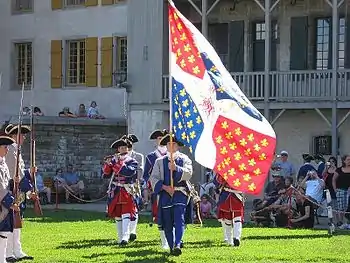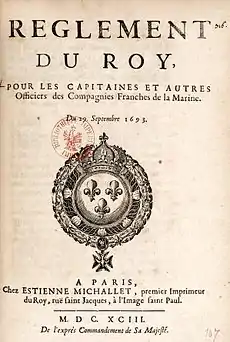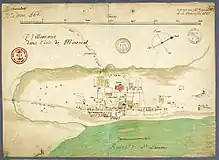French Marines in Canada, 1683–1715
The Troupes de la marine served in Canada during the period 1683–1715. The Marines were first sent to Canada in 1683 after an upsurge of Iroquois hostilities. The basic unit of the Marines in Canada was the company, with three or four officers, two sergeants, four corporals and lance-corporals, and a total complement of 33 to 52 officers and other ranks. The number of marines during the period peaked in 1688 with a total strength of 1,750 officers and other ranks. The other ranks were recruited in France, and were mostly volunteers, although Canada was not an attractive place to serve in. Unskilled labourers dominated and almost a third of them came from the western parts of France. On the other hand, the officer corps was the subject of a gradual process of canadianization, with about a third of the officers serving in 1715 born in Canada.

Background
The war with the Iroquois forced the French to deploy a regular army regiment to Canada in 1665. The additional military manpower of the Carignan-Salières Regiment tipped the scale in favour of the French, and the Iroquois sued for peace in 1667. By 1671 all regular army soldiers were back in France, or settled as colonists. When the Iroquois resumed hostilities ten years later, the colony was once again unable to defend itself in spite of the foundation of a militia system in 1669. The minister of marine, also in charge of the French colonies, therefore began to deploy Troupes de la marine to Canada in 1683.[1]
Organization

The object of the first troupes de la marine sent to Canada in 1683 was to defeat the Iroquois, and then return to France. La Barre's failed expedition against the Senecas in 1684 changed this, and from the following year the troupes became a permanent standing force in the colony, the colonial regular troops.[2] [3]
Table of organization for one company
The basic structure of the compagnies franches de la marine, as the infantry of the troupes de la marine were called after 1690, remained unchanged between 1690 and 1761.[4] Through the initiative of governor Denonville, the rank of second ensign was added to the complement in 1699, explicitly in order to recruit young Canadians of good families to the officer corps.[5] Although the free companies per definition lacked a higher organization, a small staff existed above company level, containing a surgeon, a chaplain, a clerk of the muster, and a drum-major. In 1687 the rank of "commandant of the troops in Canada" was created, with a major as his chief of staff added to the organization in 1691.[6]
| Years | Captain | Lieutenant | Ensign | Second Ensign | Sergeants | Corporals | Lance-corporals | Drummer | Fusiliers | Total |
|---|---|---|---|---|---|---|---|---|---|---|
| 1683–1686 | 1 | 1 | 0 | 0 | 2 | 3 | 3 | 0 | 42 | 52 |
| 1687–1698 | 1 | 1 | 1 | 0 | 2 | 3 | 3 | 1 | 41 | 53 |
| 1699–1715 | 1 | 1 | 1 | 1 | 2 | 3 | 3 | 0 | 22 | 33 |
| Sources: [7] | ||||||||||
Strength
The original 150 marines of 1683 increased the next year to 500, and with the arrival of governor Denonville, bringing an additional 300 men, reached a strength of 800 marines in 1685. Two years later an additional 800 marines arrived from France. In 1688 the required strength was 1,750 other ranks, although due to losses the actual strength was 1,418. The 35 substrenght companies were consolidated to 28, with 50 other ranks in each. A reduction from 50 to 30 men per company took place in 1699, reducing the required strength to 840 other ranks.[8] [9]
| Years | Number of companies | Number of officers | Number of non-commissioned officers, privates, and drummers |
|---|---|---|---|
| 1683 | 3 | 6 | 150 |
| 1684 | 10 | 20 | 500 |
| 1685–1686 | 16 | 32 | 800 |
| 1687 | 32 | 96 | 1600 |
| 1688 | 35 | 105 | 1750 |
| 1689–1698 | 28 | 112 | 1400 |
| 1699–1715 | 28 | 112 | 840 |
| Sources: [7] | |||
The actual strength were always somewhat lower than the required strength. Officer's billets were always filled, but the actual number of private marines were almost always lower than the required strength. With the reduction of the number of companies from 1689, there were a small surplus of officers from the reduced companies, serving as extra officers.[10]
Recruitment
Recruits had to be 20–30 years old, 158 cm tall, and fit for service. Single men were preferred. Most of the recruits were volunteers, but since service in Canada was not attractive, sometimes deception or violence was used to induce young men into the Marines. Wishing to avoid such chicanery, the government removed the height requirement and gradually lowered the age requirement until it was set at 15 in 1706. Catholic prisoners of war from Ireland and Scotland also became available for recruitment. When Canada urgently needed more marines, both deserters and civilian criminals, who had not been subject to corporal punishment, were released if they enlisted for military service in Canada. Sometimes prisoners were sentenced to serve in the Marines in Canada, something that hurt volunteer recruitment. From 1686, each newly raised company also included a veteran core of 14 non-commissioned officers and men from the Marine guards in French ports.[11]
Pay
| Rank | Monthly pay livre française |
Monthly bonus livre française |
|---|---|---|
| Ship-of-the-line lieutenant, as Captain | 83.4 | 50 |
| Ship-of-the-line ensign, as Lieutenant | 50 | 20 |
| Ship-of-the-line ensign, as Ensign | 50 | 15 |
| Sergeant | 22.10 | 0 |
| Corporal | 15 | 0 |
| Lance-corporal | 12 | 0 |
| Fusilier | 9 | 0 |
| Sources: [12] | ||
Stoppages were made from the pay for the uniform and for the extra blanket needed in the Canadian climate. Further deductions were for the pay of the drum major and the surgeon, and for keeping the muster-roll and maintaining the military hospital. Even the recruitment expenses were deducted. Sometimes the marines could work for the civilian population, or as officers servants, earning welcome additional income. [13]
Quarters

Most of the marines were stationed in and around Montreal. A barracks housing 100 marines were built but most of the troops were in wintertime billeted with the inhabitants. In Quebec and Trois-Rivieres the barracks was big enough to house the marines stationed in those towns. In summer the marines lived in tents.[14]
Campaigns
Drill and duties
The marines drilled with muskets twice a week, and practiced with grenades once a week. One marine from each company were selected for extended training in handling cannons, mortars and grenades. When trained, these marines were replaced by another set of marines. Standing guard was a perpetual duty, winter or summer. When living in tents in summertime, the marines were doing road work or working on the colony's fortifications. Transportation of goods to the Western posts, and of fur back to Montreal, was also the task of the marines. Military patrols on the large rivers and through the settled areas in search of hostile Indians were the most important military duty performed outside actual combat.[15]
Major campaigns and engagements

- La Barre's expedition against the Senecas, 1684.
- Troyes' Hudson Bay expedition, 1686.
- Denonville's expedition against the Senecas, 1687.
- Defence of Lachine against the Iroquois, 1689.
- Manthet's and Sainte-Hélène's expedition against Schenectady, 1690.
- Engagement on Lac des Chats with the Iroquois, 1690.
- Defence of Quebec against the English, 1690.
- Engagement at Îles-Bouchard with the Iroquois, 1691.
- Defence of La Prairie against the English, 1691.
- Engagement at Chambly against the English, 1691.
- Engagement on Lake Saint Francis with the Iroquois, 1692.
- Defense of Fort Verchères against the Iroquois, 1692.
- Manthet's and Courtemanche's expedition against the Mohawks, 1693.
- Frontenac's expedition against the Oneidas and the Onondagas, 1696.
- Iberville's expedition against Pemaquid, 1696.
- Iberville's Avalon Peninsula campaign, 1696–1697.
- The battle of Hudson's Bay, 1697.
- Beaubassin's New England campaign, 1703.
- Rouville's expedition against Deerfield, 1704
- Subercase's expedition against Newfoundland, 1705.
- Saint-Ovide's and Costebelle's expedition against Newfoundland, 1708–1709.
- Ramezay's expedition against the English at Lake Champlain, 1709.
Source: [16]
Social history
Social origin
The majority of marines in Canada had been unskilled labourers in civilian life. Yet, there were also skilled craftsmen among them, such as masons, carpenters, and tailors.[17]
Geographical origin
| Region | Marines with geographical origin registered in archival sources 1683–1715 N=1,508 |
Marines marrying in Canada 1683–1715 N=667 |
Captains 1683–1739 N=67 |
|---|---|---|---|
| Bretagne | 11% | 9% | 7.5% |
| Normandie | 8% | 10% | 7.5% |
| Paris, Ile-de-France | 9% | 7% | 28% |
| Loire: Anjou, Maine, Orleanais, Touraine | 9% | 8% | 9% |
| North: Artois, Flandre, Picardie | 2% | 2% | 1.5% |
| East: Alsace, Bourgogne, Bresse, Champagne, Franche-Comté, Lorraine, Lyonnais | 5% | 4% | 7.5% |
| West: Poitou, Aunis, Saintonge, Angoumois | 28% | 32% | 7.5% |
| Center: Limousin, Marche, Auvergne, Berry, Bourbonnais, Nivernais | 6% | 9% | 8% |
| South-East: Languedoc, Roussillon, Dauphiné, Provence, Franche-Comté, Comtat Venaissin | 4% | 4% | 10.5% |
| South-West: Guyenne, Gascogne, Béarn, Rouergue | 13% | 14% | 7.5% |
| Outside France | 2% | 2% | 7.5% |
| Sources: | [18] | [19] | [20] |
Canadianization of the officer corps
Several factors led to a gradual canadianization of the officer corps. Young Canadians of good family were from 1699 encouraged to become officers in the marines. Retired marine corps officers settling in Canada, also sent their sons into the corps as cadets, although the formal rank of cadet was not introduced until 1731. A Canadian military elite emerged; already in 1690 a quarter of the officers were born in Canada, and in 1720 about half.[21]
| Year | Percentage Canadian-born captains |
|---|---|
| 1683–1690 | 0 |
| 1691–1693 | 7 |
| 1694–1699 | 10 |
| 1700–1701 | 14 |
| 1702–1703 | 21 |
| 1704 | 14 |
| 1705 | 10 |
| 1706–1709 | 14 |
| 1710–1711 | 29 |
| 1712 | 32 |
| 1713–1714 | 29 |
| 1715 | 32 |
| Source: [22] | |
References
Citations
- Chartrand 1993, pp. 64–69, 72–73.
- Russ 1971, pp. 45–46.
- Chartrand 1993, p. 83.
- Russ 1971, pp. 23–25.
- Chartrand 1993, p. 84-85.
- Chartrand 1993, p.108.
- Cassell 1987, Appendix B.
- Russ 1971, pp. 44–50.
- Chartrand 1993, p. 84.
- Chartrand 1993, p. 111.
- Russ 1971, pp. 70–74, 76–77.
- Russ 1971, pp. 23–24. 93.
- Russ 1971, pp. 82, 93, 96–98.
- Russ 1971, pp. 87–90, 95.
- Russ 1971, pp. 92, 95, 98–99.
- Dechêne 2008, Appendix A & B.
- Russ 1971, p. 72.
- Sévigny 1989, p. 51.
- Sévigny 1989, p. 56.
- Lalancette 2015, p. 43.
- Chartrand 1993, pp. 85–86.
- Lalancette 2015, Tableau C.
Cited literature
- Cassel, Jay (1987). The troupes de la marine in Canada, 1683–1760. Thesis. University of Toronto.
- Chartrand, René (1993). Canadian Military Heritage. Vol. 1. Montreal: Art Global, Inc.
- Dechêne, Louise (2008). Le Peuple, l’État et la Guerre au Canada sous le Régime français. Montréal: Les Éditions du Boreal.
- Lalancette, Louis (2015). Les capitaines des troupes de la Marine de 1683 à 1739. Département d’histoire, Université de Montréal, Faculté des arts et des sciences. Mémoire du grade de maître ès arts.
- Russ, Christopher John (1971). Les troupes de la marine, 1683–1713. Thesis. Department of History. McGill University.
- Sévigny, André (1989). "Le soldat des troupes de la marine (1683–1715)." Les Cahiers des dix 44: 39–74.
